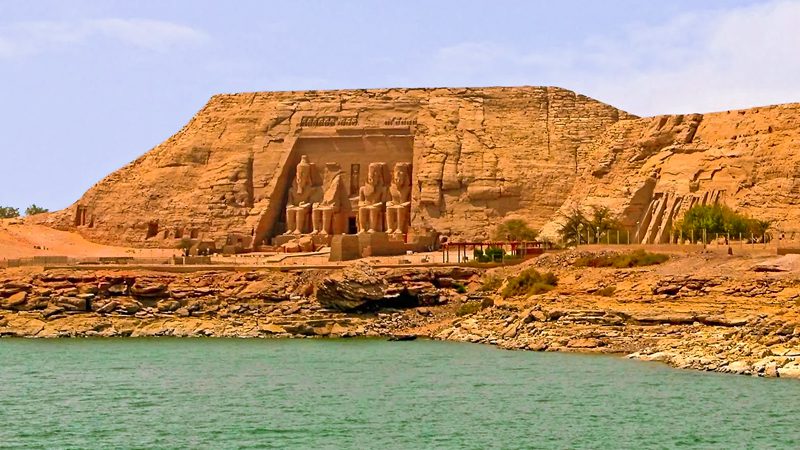Welcome to the mesmerizing world of Abu Simbel Temples, an awe-inspiring testament to ancient Egypt’s grandeur and architectural brilliance. Nestled on the western bank of the Nile River in southern Egypt, the Abu Simbel Temples stand tall as enduring symbols of the Pharaonic era. This comprehensive guide will explore the historical significance, architectural splendor, and cultural importance of these magnificent structures that have captivated travelers and historians for centuries.


Unveiling the Majesty of Abu Simbel
The Abu Simbel Temples, carved into the sandstone cliffs, were constructed during the reign of Pharaoh Ramses II in the 13th century BCE. The temples comprise the Great Temple of Ramses II and the smaller Temple of Hathor, dedicated to his beloved queen, Nefertari. These temples were created to commemorate Ramses II’s military victories and showcase his divine association.
The most remarkable feature of Abu Simbel is the colossal statues guarding the entrance. The four imposing statues of Ramses II, each measuring 20 meters in height, gaze confidently across the horizon, silently conveying the might and power of the pharaoh. The intricate details in their carvings reflect the exquisite craftsmanship of ancient Egyptian artisans.
Engineering Marvels of Ancient Egypt
The construction of the Abu Simbel Temples was an incredible feat of engineering, demonstrating the advanced knowledge and ingenuity of the ancient Egyptians. The temples were strategically built to align with astronomical phenomena, particularly the solar phenomenon that occurs twice a year during the biannual Sun Festival. On these occasions, sunlight penetrates the temple’s inner sanctum, illuminating the statues of Ramses II and the sun god, Ra.
The temples underwent a remarkable relocation project in the 1960s to preserve these cultural treasures. With the threat of submersion due to the construction of the Aswan High Dam, a UNESCO-led initiative saw the temples being carefully dismantled and moved to higher ground, where they were reconstructed with meticulous precision.
Exploring the Splendors Within
Step inside the Great Temple of Ramses II, and you’ll find a series of vast halls adorned with intricate wall carvings depicting scenes from ancient Egyptian mythology and the pharaoh’s military conquests. The grandeur of the temple’s interior and the play of natural light and shadow create a truly immersive experience.
The smaller Temple of Hathor showcases the profound love between Ramses II and Nefertari. The elegant façade, featuring six statues—four of Ramses II and two of Nefertari—reflects the pharaoh’s devotion to his queen. The inner chambers of this temple boast stunning wall paintings that depict the couple in the presence of various deities, solidifying their divine legacy.
Legacy and Preservation Efforts
Abu Simbel Temples continue to serve as a testament to the rich cultural heritage of Egypt. The successful relocation project ensured their preservation and brought international attention to the need for safeguarding other invaluable historical sites. Today, Abu Simbel is a UNESCO World Heritage site, drawing visitors from around the globe to witness its grandeur firsthand.
Conclusion
Visiting the Abu Simbel Temples is an unforgettable journey through time, offering a glimpse into the ancient world of Egypt’s pharaohs. The enduring legacy of Ramses II, combined with the architectural marvels and historical significance of these temples, makes them a must-see destination for history enthusiasts, architecture lovers, and cultural explorers.
Plan your trip to Abu Simbel, immerse yourself in the captivating stories of ancient Egypt, and witness the splendor of the Abu Simbel Temples—a true testament to human creativity, engineering prowess, and the eternal pursuit of immortality.
FAQs Abu Simbel Temples:
How do I get to Abu Simbel Temples?
To reach Abu Simbel Temples, you can take a domestic flight from Cairo or Aswan to Abu Simbel Airport or join a guided tour that includes transportation. The temples are located approximately 280 kilometers southwest of Aswan, so it’s recommended to plan your journey accordingly.
What is the best time to visit Abu Simbel Temples?
The best time to visit Abu Simbel Temples is during the biannual Sun Festival. This occurs on February 22nd and October 22nd each year when the sunlight penetrates the inner sanctum, illuminating the statues. However, the temples are open year-round, and visiting during other times still offers an incredible experience.
How long does it take to explore the Abu Simbel Temples?
Exploring the Abu Simbel Temples usually takes 1 to 2 hours, depending on your level of interest and the crowd size. This duration allows you to appreciate the architectural details, admire the wall carvings, and soak in the historical significance of these ancient structures.
Are there any restrictions or guidelines for visiting the Abu Simbel Temples?
While visiting the Abu Simbel Temples, it’s essential to respect the historical and cultural significance of the site. Photography is allowed, but tripods and flash may be restricted. Additionally, visitors are advised to dress modestly and follow any instructions provided by the guides or site officials to ensure the preservation of these remarkable treasures.
Can I visit both the Great Temple of Ramses II and the Temple of Hathor?
Yes, visitors can explore the Temple of Ramses II and the Temple of Hathor. The ticket grants access to both temples, allowing you to immerse yourself in the grandeur of Ramses II’s reign and witness the beautiful tribute to his beloved queen, Nefertari.
Is there an entrance fee for the Abu Simbel Temples?
Yes, there is an entrance fee to visit the Abu Simbel Temples. The ticket price includes access to both temples and is subject to change. It’s recommended to check the current fees before planning your visit.
